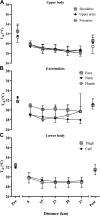Thermoregulatory responses during road races in hot-humid conditions at the 2019 Athletics World Championships
- PMID: 37022963
- PMCID: PMC10190834
- DOI: 10.1152/japplphysiol.00348.2022
Thermoregulatory responses during road races in hot-humid conditions at the 2019 Athletics World Championships
Abstract
The purpose of this study was to characterize thermoregulatory and performance responses of elite road-race athletes, while competing in hot, humid, night-time conditions during the 2019 IAAF World Athletic Championships. Male and female athletes, competing in the 20 km racewalk (n = 20 males, 24 females), 50 km racewalk (n = 19 males, 8 females), and marathon (n = 15 males, 22 females) participated. Exposed mean skin (Tsk) and continuous core body (Tc) temperature were recorded with infrared thermography and ingestible telemetry pill, respectively. The range of ambient conditions (recorded roadside) was 29.3°C-32.7°C air temperature, 46%-81% relative humidity, 0.1-1.7 m·s-1 air velocity, and 23.5°C-30.6°C wet bulb globe temperature. Tc increased by 1.5 ± 0.1°C but mean Tsk decreased by 1.5 ± 0.4°C over the duration of the races. Tsk and Tc changed most rapidly at the start of the races and then plateaued, with Tc showing a rapid increase again at the end, in a pattern mirroring pacing. Performance times were between 3% and 20% (mean = 113 ± 6%) longer during the championships compared with the personal best (PB) of athletes. Overall mean performance relative to PB was correlated with the wet-bulb globe temperature (WBGT) of each race (R2 = 0.89), but not with thermophysiological variables (R2 ≤ 0.3). As previously reported in exercise heat stress, in this field study Tc rose with exercise duration, whereas Tsk showed a decline. The latter contradicts the commonly recorded rise and plateau in laboratory studies at similar ambient temperatures but without realistic air movement.NEW & NOTEWORTHY This paper provides a kinetic observation of both core and skin temperatures in 108 elite athletes, during various outdoor competition events, adding to the very limited data so far available in the literature taken during elite competitions. The field skin temperature findings contrast previous laboratory findings, likely due to differences in relative air velocity and its impact on the evaporation of sweat. The rapid rise in skin temperature following cessation of exercise highlights the importance of infrared thermography measurements being taken during motion, not during breaks, when being used as a measurement of skin temperature during exercise.
Keywords: competition; endurance; hot temperatures; thermography; thermoregulation.
Conflict of interest statement
No conflicts of interest, financial or otherwise, are declared by the authors.
Figures











Similar articles
-
Hydration and cooling in elite athletes: relationship with performance, body mass loss and body temperatures during the Doha 2019 IAAF World Athletics Championships.Br J Sports Med. 2021 Dec;55(23):1335-1341. doi: 10.1136/bjsports-2020-103613. Epub 2021 Feb 12. Br J Sports Med. 2021. PMID: 33579722 Free PMC article.
-
Association between thermal responses, medical events, performance, heat acclimation and health status in male and female elite athletes during the 2019 Doha World Athletics Championships.Br J Sports Med. 2022 Apr;56(8):439-445. doi: 10.1136/bjsports-2021-104569. Epub 2022 Feb 14. Br J Sports Med. 2022. PMID: 35165084 Free PMC article.
-
Increased Air Velocity Reduces Thermal and Cardiovascular Strain in Young and Older Males during Humid Exertional Heat Stress.J Occup Environ Hyg. 2015;12(9):625-34. doi: 10.1080/15459624.2015.1029613. J Occup Environ Hyg. 2015. PMID: 25897617
-
Thermoregulation and marathon running: biological and environmental influences.Sports Med. 2001;31(10):743-62. doi: 10.2165/00007256-200131100-00004. Sports Med. 2001. PMID: 11547895 Review.
-
Adaptation to hot environmental conditions: an exploration of the performance basis, procedures and future directions to optimise opportunities for elite athletes.Sports Med. 2015 Mar;45(3):303-11. doi: 10.1007/s40279-014-0277-4. Sports Med. 2015. PMID: 25380791 Review.
Cited by
-
Thermal and Biomechanical Responses of Amateur, Elite and World Cup Athletes During a World Cup Sprint Triathlon in the Heat.Sports Med. 2025 Jun;55(6):1515-1526. doi: 10.1007/s40279-025-02193-7. Epub 2025 Mar 27. Sports Med. 2025. PMID: 40146472 Free PMC article.
References
-
- Intergovernmental Panel on Climate Change. Climate Change 2021: The Physical Science Basis. https://www.ipcc.ch/report/ar6/wg1/ [2021].
Publication types
MeSH terms
LinkOut - more resources
Full Text Sources
Research Materials

